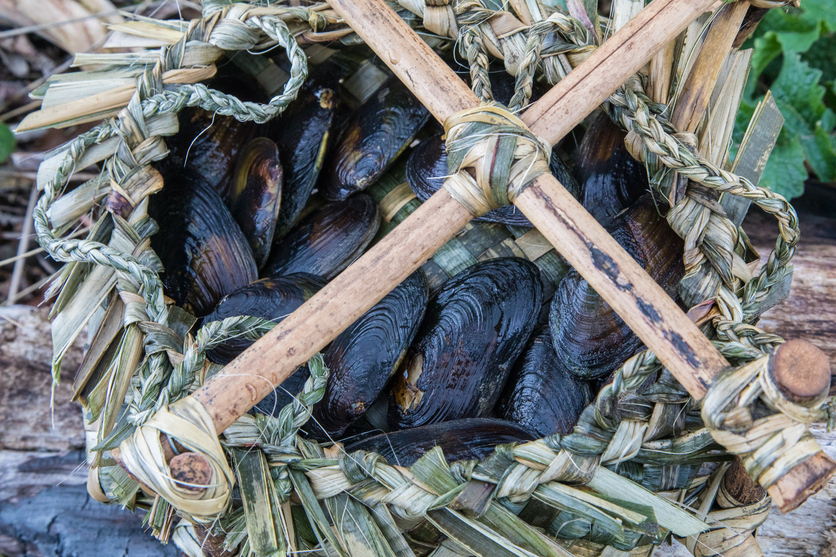Kākahi may not be the most well known of our native species, but they are critical to the health of our waterways. In this story, we'll meet Amber McEwan who is exploring both mātauranga Māori and western knowledge to help bring them back from the brink.
This is part of the series In Her Nature: New Zealand women changing the way we connect with the world around us, exploring New Zealand women scientists working at the intersection of people and nature. These stories are a feature for the International Day of Women and Girls in Science 2020.
Exploring and expanding our knowledge of kākahi
Amber McEwan is at home in the water. She’s a freshwater ecologist studying kākahi, New Zealand’s threatened freshwater mussels, in Wairarapa Moana/Lake Wairarapa.
Kākahi live in lakes and waterways across New Zealand but are increasingly at risk from pollution and habitat loss. Most of New Zealand’s mussel populations are large adults, which means that juvenile kākahi are not surviving until adulthood. Amber is exploring the best ways to move kākahi to new locations as part of conservation efforts to help them survive and reproduce effectively.
“My PhD topic is translocation ecology of freshwater mussels, which is an umbrella term for lots of different pieces of work that I’m weaving together. Under the umbrella at the moment is looking at mātauranga Māori methods and looking at the best way to transport them for translocation.”
Kākahi have been a traditional mahinga kai/food source for Māori, and Amber wanted to test whether there are differences between moving kākahi in traditional kete/flax baskets, in buckets or in a hybrid of the two (a kete inside a bucket).
Kākahi were gathered from three sites across the region, working with mana whenua Taranaki Whānui, Ngāti Kahungunu ki Wairarapa and Rangitāne o Wairarapa to create locally specific kete. Two hundred kākahi were then moved to Wellington’s ZEALANDIA ecosanctuary, where they will contribute to a rich and healthy freshwater ecosystem.
“The science was measuring how quickly they were able to secure a position in the sediment and how quickly they could burrow after being transported using one of those methods. And essentially, the main finding was the ones that were immersed in water the whole time did better.”
The importance of community connections
As much as she loves working with the kākahi themselves, Amber values the connections being made with mana whenua and the knowledge that is being developed across both. Working with mana whenua and local communities is critical to the success of Amber’s research and her wider goals of protecting Wairarapa Moana. More people are taking part in Greater Wellington’s annual monitoring, where volunteers count and measure kākahi in the lake, checking their health and making note of shell erosion and other health indicators. Amber is seeing the benefits of working closely with the community.
“Now, we’re getting more locals who live here and are able to bring a different perspective, and hopefully have more ownership of it all. Sometimes all it takes is one outspoken, motivated person to make a big difference in these areas. And there’s a few of those people down here. I think that at least in Lake Wairarapa that mana whenua are getting closer together, and the Western scientists and mana whenua are getting closer together on lake work.”
Related content
Read about Dr Priscilla Wehi’s research and how she applies mātauranga Māori principles and knowledge to her research.
In Awhi mai awhi atu – kuku restoration, find out how Dr Kura Paul-Burke uses both mātauranga Māori and science to help restore the mussel beds in Ōhiwa Harbour.
For an introduction to mātauranga Māori and science, read this article, and to discover many more resources, explore our mātauranga Māori topic.
Want to incorporate mātauranga Māori in your teaching? See these two recorded PLD webinars Mātauranga Māori and Mātauranga and the Living World.
Read Scientists and tamariki working together – one of the PSP Ahi Pepe MothNet project’s goals is to connect with mātauranga Māori.
Project Mātauranga is a television series that investigates Māori world views and methodologies within the scientific community. Reviving toheroa looks at the work to revive toheroa, a taonga shellfish.
The 2014 Connected article Counting kākahi tells the story of a freshwater scientist investigating black mussels in our lakes and rivers.
The article Working as a scientist provides a brief overview of some of the many scientists featured on the Hub. Use it to discover some of the reasons people choose a science-related career and some of the things you can do if you are curious to begin a career in science.
Useful links
You can read Amber’s full research paper here, or find out more about the children’s books she’s developed here.
Watch Amber discuss kākahi during a monitoring session in Lake Wairarapa. The video is one of several featured in Our Lakes, Our Futures' Lake stories.
Read more about the release of rare kākahi (freshwater mussels) at ZEALANDIA in this Stuff news article.
To explore different aspects of mātauranga Māori and research utilising science and mātauranga Māori, have a look at our Pinterest curation of resources here.
Use these Pinterest boards for more profiles of people working in science.
Acknowledgement
This article was written by Anastasia Turnbull.



